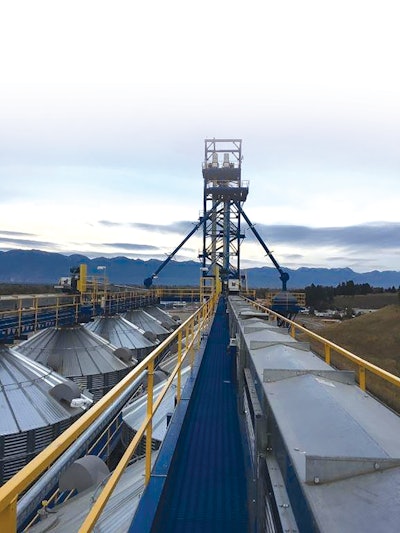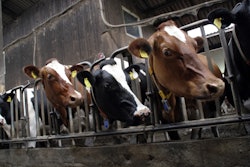
The picturesque mountain town of Kalispell, MT, has undergone quite a transformation in the last decade. Since 2010, the population has exploded by almost 20% to nearly 24,000 people. Along with it, the landscape of the community changed, bringing more tourism, shops and pedestrians to the city’s downtown.
This downtown expansion butted up against the area’s industrial past. For more than a century, one of the main staples of downtown Kalispell was a grain elevator, owned by CHS Mountain West, headquartered in Missoula, MT, and Kalispell.
The 350,000-bushel grain elevator was situated on the railroad at the edge of town when it was built in 1908. But by the mid-90s, the elevator became enveloped by the town’s center. A 48-car grain train would block seven of the town’s eight intersections when it pulled into the elevator, remembers Mark Lalum, general manager, CHS Mountain West. As inconvenient as it was for tourists and residents, the elevator was crucial to the cooperative’s grain division.
CHS Mountain West in Kalispell serves farmers across western Montana, handling 2 million bushels a year.
“It’s essential to our farmers because the nearest elevator outside of Kalispell is 320 miles away,” says Lalum. “We are the only avenue to get their grain to market.”
Lalum says that 18 years ago CHS began planning a relocation to both improve traffic downtown and to update the aging grain handling and storage equipment.
While the idea was well-received by all stakeholders, financial backing proved challenging, and the project was put on hold. Then five years ago, the city and county jointly approached the cooperative to re-open discussions about financing a new location.
TIGER grant spurs big move
After nearly three years of planning among Kalispell city officials, the Flathead County Economic Development Authority (FCEDA), the U. S. Department of Transportation, BNSF Railroad and CHS Mountain West, the project was awarded a $10-million TIGER (Transportation Investment Generating Economic Recovery) grant in 2018.
The DOT grant allowed the city and county to move forward with the project, the revitalization of downtown Kalispell, and the removal of the tracks. FCEDA was to financially assist in building a new 475,000-bushel grain elevator, unit train loader and 4,500-ton fertilizer facility and a 32,000-sqare-foot warehouse/shop/retail store/office at Glacier Rail Park on Kalispell’s east side. CHS Mountain West sold the land from its downtown location to FCEDA for another $3.2 million. Finally, moving and upgrading Kalispell’s elevator was within reach.
Through a bid process, CHS Mountain West selected Steuve Construction, Algona, IA, to build the $14.5-million facility at the new 40-acre industrial park on the BNSF Great Northern Corridor.
Construction started in June 2018 and was completed in November 2019. Lalum says Glacier Rail Park was a former gravel pit, naturally providing excellent drainage and solid foundation. Construction carried on smoothly, and the new facility began accepting grain last harvest season while construction crews completed the shipping side of the grain elevator and the warehouse.
Facility features
The traffic flow on the grain receiving side is laid out in a figure-eight with a Gamet Mfg. Inc. truck probe in the center. At the end of one loop is the 600-bushel dump pit, and at the other end is the Unitec truck scale.
All of the facility’s grain handling equipment was furnished by Warrior Mfg., including two 10,000-bushel/hour bucket elevators, two 10,000-bushel/hour overhead drag conveyors, two 20,000-bushel/hour enclosed belt conveyors for rail loadout, a 20,000-bushel/hour bulk weigh loadout scale and a 25,000-bushel/hour screener.
For storage, there are two rows of seven 27-foot-diameter steel hopper bins by Sukup and a 162-foot-tall tower support with switchback stairs by Warrior Mfg. Each bin can hold 33,750 bushels of grain for a total storage capacity of nearly 475,000 bushels.
The loadout uses Cultura’s oneWeigh bulkweigh control system, and the receiving is automated by Sweeney Controls. Operating the grain side of the facility requires only two full-time employees.
Lalum predicts minimal wait times at harvest. The old facility received at 3,500 bushels/hour and trucks had to pull forward to dump grain from their second hoppers. Now it takes only three minutes to unload, and trucks can dump both hoppers at once“We upgraded from a horse and buggy to a Lamborghini,” says Lalum. “Before, we could only load two rail cars at a time, which took 20 to 35 minutes each. Now we can load a car in 10 minutes.”
The facility will load more than 600 train cars/year, typically in 24-car trains. However, it has the capacity to load 48-car trains and can hold up to 65 cars on its ladder track.
Letting go for growth
While the new elevator is faster, provides more storage for farmers and improves efficiencies, it’s bittersweet for the community to lose part of its original landscape. In late June, FCEDA will finish dismantling the last of the old steel elevator’s bins to reclaim the land and then the city will remove the tracks to open the downtown rail corridor.
“The old elevator still feels nostalgic for some people,” Lalum says. “Looking at our history, the railroad was key to its early success by shipping farm products to the rest of the world. That elevator helped put Kalispell on the map, and now it’s time to let Kalispell grow.” ■
At-A-Glance: CHS Mountain West
Headquarters: Missoula, MT and Kalispell, MT
Year Orignal Partner was Founded: 1917
Total Members: 2,500
Region served: Western Montana
Services provided: Grain storage, agronomy, feed, propane, retail goods
Total locations: 14
Employees: 155
DIVERSITY IS KEY TO PROFITABILITY
CHS Mountain West in Kalispell, MT, handles up to eight different commodities each year, including spring wheat, winter wheat, soft white wheat, malt barley, barley, peas, canola and garbanzo beans.
Mark Lalum, general manager, CHS Mountain West, says the mountain valley’s crop diversity helps farmers and commercial grain handlers make a profit even in challenging years.
“We’ve had difficult years because of our shorter growing season and climate,” Lalum says. “We don’t see any corn or soybeans around here, but we’ll handle anything the valley raises to protect ourselves from the threat of a single crop having a failed season.”
Wheat usually represents the highest percentage of volume handled at the Kalispell location. But, when the wheat harvest is small or poor quality, they lean on hardy crops like canola that can withstand less-than-desirable growing conditions without impacting quality.
Handling commodities like malt barley and peas also pays off. Storing and maintaining the quality of such crops can be difficult over the long term, but the Kalispell elevator was designed with minimal storage, so it ships out high-demand products quickly. The strategy works well for CHS Mountain West.


















